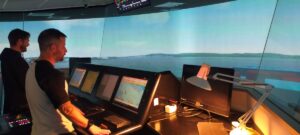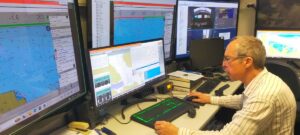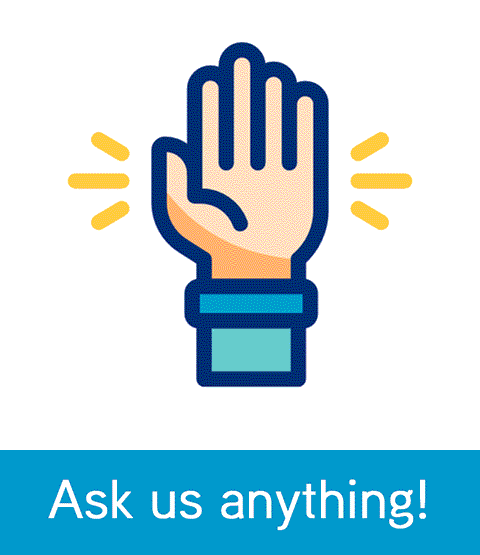New, high-tech digital navigation tools are being tested at New Zealand Maritime School (NZMS) in downtown Auckland.
Toitū Te Whenua Land Information New Zealand (LINZ) and Maritime New Zealand are working together to create high-tech digital navigation tools based on the global S-100 standard.
LINZ and Port of Auckland were trialling these new tools at the maritime school’s Simulation Centre at City Campus on the 3rd and 4th of July.
The S-100 standard, which will be used in countries around the world, will transform how mariners access and use data such as electronic charts, water levels, ocean surface currents and navigational warnings.
It will improve planning and decision leading to increased safety, faster journey times, optimised loading capacity for container ships, and environmental benefits.

Port of Auckland staff looking out to a virtual Waitematā Harbour in the largest bridge at the simulation centre
Kees Buckens, NZMS’s Industry Engagement and Simulation Centre Manager, says it is exciting to be involved with the transformation.
Located right on the waterfront at the school’s City Campus, the Simulation Centre is the largest maritime simulator in the Southern Hemisphere. It has seven bridge simulators which replicate a vessel’s principal control centre.
These simulators allow NZMS ākonga to learn various aspects of navigating and piloting large vessels while simulating real environments like the Waitemata Harbour. The environments that can be simulated include all the ports in New Zealand and other major ports around the world.
The exercises in the bridges are controlled in the instructor room. In this room, various elements like tides, weather and other vessels are introduced to the exercise providing trainees with a very real experience.

NZMS’s Kees Buckens controls what happens in the bridge from the instructor room
New Zealand Maritime School comprises the City Campus on Commerce St and Mahurangi Campus in Warkworth.
Across the two campuses, programmes are available in marine engineering, domestic maritime, nautical foreign-going and super yacht crewing. The programmes include diplomas, certificates and short courses.
Most ākonga at the maritime school are new to the industry, but NZMS also works closely with New Zealand’s marine industry on upskilling people already working. People who have taken these programmes often end up in senior jobs all around the world.
New Zealand Maritime School is operated by MIT.






